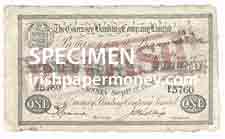
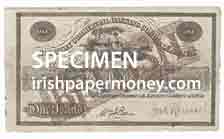
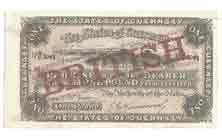
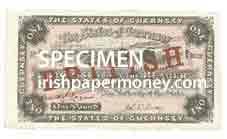
In 1921 the government of the States of Guernsey decided to realign the value of the Guernsey Pound to parity with sterling, by breaking a long-standing link to the French Franc and adopting sterling as the only Legal Tender on the island.
This decision resulted in a short interim issue of banknotes whereby all notes issued on the island were overprinted in red with ‘BRITISH’ within a border in large letters distinguishing them from earlier issues.
The overprinted notes were quickly replaced in circulation by new designs.
There are four distinct designs of Guernsey overprint known, spread over the One Pound notes of three issuing entities. All of the overprinted notes are rare.
In the early 1800s the administrative regions of the British Isles and Channel Islands all used the Pound as a unit of currency, with local Pounds having slightly differing exchange rates against sterling. There was a gradual change to sterling becoming the standard unit of currency.
The Irish Pound was separate up to 1826 when it was abolished in favour of sterling [1. Honohan 2002], The Jersey Pound was linked at par with sterling in 1877 [2. McCammon, 1984, p185], and the Guernsey Pound was fixed at par with sterling in 1921. These ‘regional Pounds’ were inferior to sterling in that they had an extra penny to the sterling shilling.
In addition to the Pound in the channel Islands the French Livre Tournois system was the currency standard, the Livre being a gold coin, subdivided into 20 Sous that had been the currency of France before the introduction of the Franc. Up to 1834, the French Livre was used as the unit of currency in Jersey and Guernsey [2. McCammon, 1984].
Although France had substituted the Franc in place of the Livre as its currency unit in 1795, the Livre continued to be used in the Channel Islands. In Jersey 1 sou was equal to a Jersey halfpence. This further worked out as 2 sous = 1d; 26 sous = 13d = 1 Shilling. Thus there were 26 Livres to the British Pound. In Guernsey, the Livre had been fixed in value relative to the British Pound in 1723 [3.]. Because of this link to the Pound sterling, the Guernsey Livre gradually became worth more than the French Livre, due to the continued devaluation of the French Livre.
In 1834, in Jersey an exchange rate was fixed at 26 French Livres equal to one Sovereign, establishing sterling as the standard in Jersey. Thus, 26 Livres equaled 20 Shillings. This resulted in a rate of 13 Jersey pence to 1 Shilling British – interestingly this is the same rate at which the Irish Pound had been fixed to the English Pound by proclamation in June 1701 [Honohan 2002], a state which continued until Irish currency union with sterling in 1826.
In 1877 Jersey revalued its currency to parity with sterling when the 1/13 th of a Shilling coin became 1/12 th of a Shilling.
1n 1830, Guernsey introduced a new currency, the Double (a name derived from the French ‘double deniers’), in the form of copper coins, its own currency which was used along with the Livre. The value of the Double was set at 80 to 1 French Franc [4.].
In Guernsey, a dual British and French standard had been set in place by an Ordinance of 3 September 1870 [5. Du Quesne Bird, N. 1974], which lasted until March 1921. This lead to the statement of face value on early States of Guernsey notes denominated in shillings being stated in Shillings and in Francs, with notes of 5 Shillings / 6 Francs and 10 Shillings / 12 Francs being issued.
According to McGammon, these shilling-denominated notes were first introduced in 1914 as a locally printed emergency issue of 5 Shilling and 10 Shilling notes both dated 5th August 1914. This first issue was quickly replaced by a new standard issue, printed by Perkins Bacon, with both denominations dated 1st September 1914. Examples of both issues are pictured in Fig. 1.
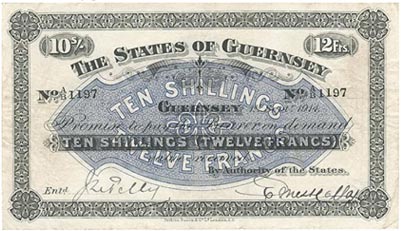
Fig. 1a. The States of Guernsey, 10 Shillings – 12 Francs, dated 1st Sept. 1914. [DNW, 27 Sept. 2006, Lot 2185]
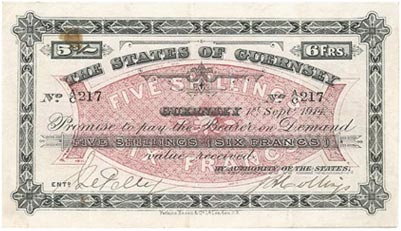
Fig. 1b. The States of Guernsey, 5 Shillings – 6 Francs, dated 1st Sept. 1914. [DNW, 27 Sept. 2006, Lot 2183]
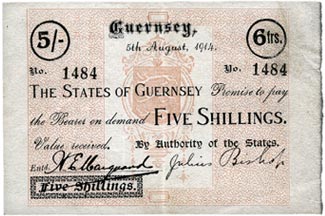
Fig. 1c. The States of Guernsey, 5 Shillings – 6 Francs, dated 5th August 1914. [DNW, 30 Sept. 2010, Lot 2651]
An Ordinance of 4th August 1914 made banknotes issued by The States of Guernsey legal tender; notes issued by the two commercial banks of issue were not made legal tender [5. Du Quesne Bird, N. 1974].
The note issues of the Guernsey private banks consisted entirely of One Pound notes. Several small private banks issued notes in the early 1800s. The earliest recorded banknote appears to be a One Pound note dated 1 September 1808, issued by Bishop de Jersey & Co., operating as ‘Guernsey Bank’ [McCammon 1984, p199, GN1]. The notes issued by this bank promised to pay the bearer on demand in a ‘Bank of England Note’, which implied One Pound sterling. All of these banks failed around 1811.
The States of Guernsey began issuing banknotes in 1827 as a means of financing public debt. The notes did not mention sterling or British Pounds.
Two larger joint stock private banks, Guernsey Banking Company (founded 1827), and Guernsey Commercial Banking Company (founded in 1835) also issued notes.
Guernsey broke with the French Franc on 30 March 1921 [4.] as a result of a steady fall in value of the Franc after the First World War.
In 1920 the withdrawal of the silver 1 Franc and its replacement by a paper Franc in Paris was closely watched by the government of Guernsey. There was also discussion within the government of Guernsey about withdrawing the rights of the commercial banks to issue notes [5.].
Despite the French Ministry of Finance stating that French silver was ‘not being withdrawn’ and that demonetised French silver still in use in Guernsey could be exchanged for paper Francs, the change to paper money and decline in the value of the Franc worried the government of Guernsey sufficiently for it to enter into correspondence with H.M. Treasury regarding a change to sterling as Legal Tender on the island, and the adoption of English silver to replace the French silver. This resulted in an agreement with H.M. Treasury to introduce sterling in Guernsey and an agreement to exchange French silver coin for British silver coin, weight for weight [5.].
A Guernsey government Provisional Ordinance of 30 March 1921 stated that after April 3rd 1921 the only legal tender in Guernsey would be British coin, Bank of England and Treasury notes, and the copper money and notes of the States of Guernsey. It further stated that the copper money of the States shall have the same value as the British copper money, and that all amounts of money in excess of one shilling would be converted according to the formula “20 new currency equals 21 old currency” [5.].
Three entities were issuing banknotes in Guernsey in 1921 – government issues: The States of Guernsey; and two commercial banks: The Guernsey Commercial Banking Company Ltd., and The Guernsey Banking Company Ltd. All three of these entities issued £1 notes with the red ‘BRITISH’ Guernsey overprint on their existing designs for a short period, until new design banknotes were ready for issue.
The first date on the new design notes of all three issuing entitles which replaced the 'BRTISH' Guernsey overprint notes was the same, 1 March 1921.
These notes of 1 March 1921 are also the last recorded notes issued by the two commercial banks. After these issues, the only banknote issue in Guernsey was that of the of the States of Guernsey.
The latest date recorded of a Guernsey Commercial Banking Company Ltd £1 note prior to its 1921 overprinted note is a £1 note dated Sept. 19, 1918, number G 8203, pictured in Fig. 2. The latest date recorded of a Guernsey Banking Company Ltd £1 note prior to its overprinted note (on a 1916, dated note) is a £1 note dated July 1st, 1909, number BG 3202, pictured in Fig. 3.
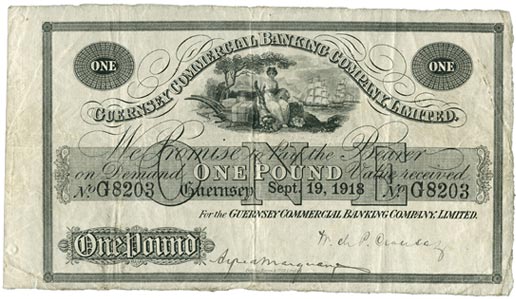
Fig. 2. Guernsey Commercial Banking Company Limited, One Pound, dated Sept. 19, 1918. [DNW, 24 Oct, 2012, Lot 61]
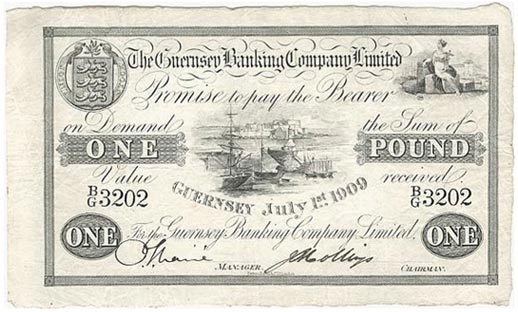
Fig. 3. The Guernsey Banking Company Limited, One Pound, dated July 1st. 1909. [DNW, 27 Sept. 2006, Lot 2161]
The BRITISH overprint was added to all States of Guernsey notes issued after 30 March 1921 until new designs of banknotes were introduced. McCammon (1984), page 204, records that 5 Shilling, 10 Shilling and £1 notes were issued in April 1921 with the Guernsey overprint added to them. Examples of the 5 Shilling and 10 Shilling notes with the overprint have not been seen in recent times, and are not available for illustration.
The latest date recorded for pre-overprinted £1 notes issued by the States of Guernsey is 15 October 1918 (numbers DG 2822, DG 2830 recorded), pictured in Fig. 4.

Fig. 4. The States of Guernsey, One Pound, dated 15th October 1918. [DNW, 24 Oct, 2012, Lot 65]
There are two distinct styles of overprint on £1 notes issued by the States of Guernsey, an earlier variant on notes dated 1 August 1919 measures 170 x 38 mm [6. DNW, 27 Sept 2006], pictured in Fig. 5, of which several examples have been recorded (including numbers, DS 3300, DT 147, DU 3081, DW 1222); and a later variant using a different typeface and different border for the overprint on banknotes dated 1 January 1921 measures 160 x 38 mm [6. DNW, 27 Sept 2006], of which one example has been seen, pictured in Fig. 6 (number DX 3632).
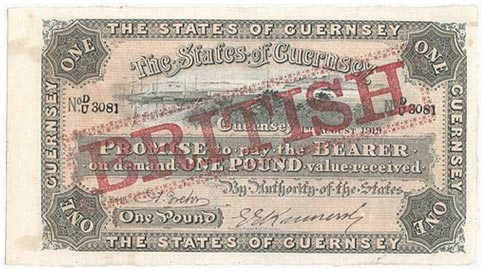
Fig. 5. The States of Guernsey, One Pound Guernsey overprint, dated 1st August 1919 with 'BRITISH' overprint, for issue in April 1921. [DNW, 27 Sept. 2006, Lot 2188]

Fig. 6. The States of Guernsey, One Pound Guernsey overprint, dated 1st January 1921 with 'BRITISH' overprint, for issue in April 1921. [DNW, 27 Sept. 2006, Lot 2189]
As DX follows on from DW, it can be concluded that it is unlikely that there are unrecorded dates between 1 Aug 1919 and 1 Jan 1921. The design was replaced by smaller new design notes dated 1 March 1921.
Prefixes on new design notes with the earliest recorded date of issue, 1 March 1921, pictured in Fig. 7, have been recorded from ED to FJ. This leaves a gap of up to five further prefixes of banknotes after 1 Jan 1921, and up to eleven further prefixes of banknotes which could have been issued with the 'BRITISH' overprints before 1 August 1919, prefix DS.

Fig. 7. The States of Guernsey, One Pound, dated 1st March. 1921, first issue after the overprinted notes. [Noonan's, 26 Feb 2020, Lot 37]
One single example of a One Pound note issued by Guernsey Commercial Banking Company Ltd with the ‘BRITISH’ Guernsey overprint has been recorded. Illustrated in Fig. 8, it is dated Jan. 3, 1921, with serial number H 2383. This note appeared in auction in DNW, London, 27 September 2006, Lot 2170, a part of the Godfrey Burr Collection.

Fig. 8. Guernsey Commercial Banking Company Limited, One Pound Guernsey overprint, dated Jan. 3, 1921 with 'BRITISH' overprint, for issue in April 1921. [DNW, 27 Sept. 2006, Lot 2170]
One example of a Guernsey Banking Company Ltd £1 note with ‘BRITISH’ Guernsey overprint has also been seen. Also from the L. G. Burr Collection [DNW, 27 Sept 2006, Lot 2162], the note is dated Sept 1st, 1916, serial number BL 5760, and is pictured in Fig. 9.

Fig. 9. Guernsey Banking Company Limited, One Pound Guernsey overprint, dated Sept. 1st. 1916 with BRITISH overprint, for issue in April 1921. [DNW, 27 Sept. 2006, Lot 2162]
Prior to this both of these banks had issued their notes denominated in Pounds, without reference to ‘British’ or ‘sterling’.
After its 1921 ‘BRITISH’ overprint, the Guernsey Commercial Banking Company Ltd. issued a completely new design modern small format note, dated 1 March 1921, with a serial number composed of prefix letter A, plus five digit number with leading zeros. One example of this note issue has been seen, number A 06496, recorded in the Royal Bank of Scotland archive. This is the last known note issue of the bank, which was taken over by National Provincial Bank in 1924 [7.]
The Guernsey Banking Company Limited also issued a new small format note to follow on from its, dated 1 March 1921, to replace its Guernsey overprint issue. Measuring 150 x 84 mm, it was generally similar in design to its earlier larger notes. An example is pictured in Fig. 10. This note issue is numbered with prefix letter A, followed by a five digit number with leading zeros, similar to the 1 March 1921 notes issued by the Guernsey Commercial Banking Company Ltd. Only three notes have been recorded, A 05974 (DNW, 27 September 2006, Lot 2163, sold for £12,000), A 22169 (DNW, 29 September 2011, Lot 4122, sold for £4,300), and A 40489 sold in 2009 [8.]. This note issue is not listed in McCammon. No other dates have been seen, and this could well be the bank’s final note issue. The bank was taken over by National Westminster Bank in 1924 [9.].
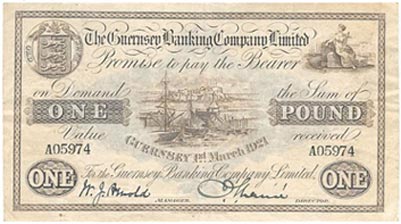
Fig. 10. Guernsey Banking Company Limited, One Pound, dated 1st March 1921, first issue after the bank's Guernsey overprint notes. [DNW, 27 Sept. 2006, Lot 2163]
The large letter design format of the Guernsey overprint might have been influenced by earlier Jersey banknote issues, some of which included the word ‘BRITISH’ in a similarly large type size which dominated the design of the notes. Whether or not the design was influenced by these earlier notes remains to be investigated.
Formerly, in Jersey some of the banknotes issued by the various banks were stated as being payable in ‘sterling’, ‘British sterling, or similar terminology, with some having BRITISH in the underprint in large letters across the face of a note. Many Jersey banks did not specify their currency of payment, using a phrase such as 'Promise to pay the Bearer on Demand ONE POUND Value rec’d', which is printed on £1 notes of the Jersey Bank dated in 1814. Two examples of the usage of ‘BRITISH’ in large lettering in the centre of a banknote are pictured in Fig. 11: a £1 note of St Mary’s Parochial Bank, dated 14th May 1901; and a £1 note of Jersey Bank printed entirely in blue ink, dated 17 October 1843.

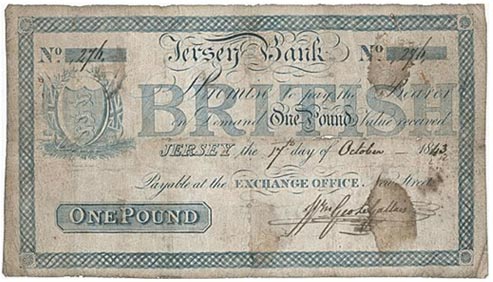
Fig. 11. Two early examples of the usage of BRITISH printed in dominant letters on the face of private banknotes issued in Guernsey, to indicate their payment in sterling. These might have served as an inspiration for the Guernsey overprint of 'BRITISH' on the States of Guernsey 1921 issues. [St. Mary’s Parochial Bank, DNW, 27 Sept. 2006, Lot 2565] [Jersey Bank, DNW, 15 March 2007, Lot 3095]
The short-lived Guernsey ‘BRITISH’ overprints are reminiscent of this design. While ‘BRITISH’ in large lettering was an integral part of the Jersey notes, it was added as an overprint in red to the standard design of the three note issuers in Guernsey in 1921.
Although superficially similar in appearance on the £1 notes of all the issuers, the design of the Guernsey overprint differs on the notes of each of the two commercial banks, and from the two overprint styles on the States of Guernsey notes, giving a total of four distinct overprint styles.
Variations in Overprints on Different Notes
An analysis of the overprints on the prefix DS, DU and DW notes by superimposing images of each note on top of the other indicates that while the position of the overprint is different on each of the notes the size and text of the overprint overlap precisely. Additionally, the angle of the overprint on each of these notes is exactly the same, measured at 15 Degrees off horizontal. The angle of the overprint on the DX prefix note, dated 1921 is 11 Degrees.
On the £1 note of the Guernsey Commercial Banking Company Limited, the overprint is at an angle of 23 Degrees, and on the £1 note of the Guernsey Banking Company Limited the overprint is at an angle of 9.5 Degrees.
The surrounding border of the overprints are also different to each other, being most ornate on the Guernsey Commercial Banking Company Limited £1 note.
Considering that the dates on some of the notes bearing the Guernsey overprint are several years behind their issue date, 1916 in the case of the Guernsey Banking Company Limited, and 1919 in the case of the States of Guernsey, it can be concluded that the banks had stocks of notes printed earlier.
Five prefixes are covered by the observed overprints on the States of Guernsey notes dated 1 August 1919, with DS, DT, DU and DW having been recorded. As notes with prefix DX have a later date, 1 Jan 1921, and a different typeset for the overprint, it is assumed that these were a new printing on existing blank un-numbered notes to use them up, or an entirely new printing of notes needed before the new design was ready.
Having previously used a letter over letter prefix (seen on £1 notes dated 8 Jan 1908 AG 7533), the Guernsey Commercial Banking Company Limited appears to have restarted its prefixes at A when the bank became a Limited company and ‘Limited’ was added to the notes below the bank title. Notes dated 9 March 1916 bear prefix D, those of Sept 9th 1918 have prefix G (pictured in Fig. 2) and have been redesigned so as to integrate ‘Limited’ into the full bank title across the top, and the note dated Jan 3rd 1921 with the ‘BRITISH’ overprint has prefix H. Each prefix has a serial number up to four digits.
The Guernsey Banking Company Limited banknotes used a prefix of letter over letter plus a number up to four digits. Notes dated 1 Sept 1903 have prefix BD, those of 1 July 1909 have prefix BG. The next recorded date is 1 Sept 1916, with the ‘BRITISH’ overprint. Four sub-prefixes were used during the seven year gap between these dates, and 1916-dated notes remained to be used up by 1921.
The government issue of banknotes was many times larger than that of both of the commercial banks combined. Based on the serial numbers on observed notes, it can be concluded that the issues of the two commercial banks was very small. Surviving examples of any banknotes of these two joint stock commercial banks are seldom offered.
There is little mention in numismatic literature of the ‘BRITISH’ overprinted notes issued by the commercial banks, Guernsey Banking Company Limited and Guernsey Commercial Banking Company Limited. The first mention of them appears to be in McCammon’s ‘Currencies of the Anglo-Norman Isles - Supplement’ (1993 p.3) when he lists two dates for Guernsey Banking Company Limited as overprinted ‘BRITISH’ in red, 1.9.1916 and 3.1.1921. It appears that an error was made here, as the recorded note dated Jan 3, 1921 with overprint was issued by the Guernsey Commercial Banking Company. An example of each of these notes subsequently appeared in the DNW sale of the L. G. Burr collection in 2006.
McCammon lists two dates for BRITISH overprints on £1 notes issued by The States of Guernsey, 1.9.1914, and 1.8.1919 in ‘Currencies of the Anglo-Norman Isles’ (1984), page 204, GN26. These two dates are also listed in ‘Currencies of the Anglo-Norman Isles - Supplement’ (1993)(10).
Considering that non-overprinted examples of States of Guernsey £1 notes, dated 1 September 1917, number CU 429 (11. Banknote Yearbook, 11th Ed., 2021, page 230) and 15 October 1918, number DG 2822 (Noonans, 24 Oct 2022, Lot 65) have been recorded, as well as a £1 note dated 10 August 1914 (DNW, 30 Sept, 2010, Lot 2653), the date 1.9.1914 listed in McCammon (1984 and 1993) for overprinted £1 notes may be considered a likely typographical error, especially as this date was that used on 5 Shilling and 10 Shilling notes, which are also listed in McCammon (1984 and 1993) as being issued in 1921 with ‘BRITISH’ overprints – examples of these notes are not currently available for study.
In the 1993 supplement to Currencies of the Anglo-Norman Isles McCammon lists the States of Guernsey 1 January 1921 overprinted note as an addition to GN26, with the 1.9.1914 date also being left in place.
All of the overprinted notes are very rare. Printage figures for notes of the two commercial banks are very low as discussed previously, and prefix evidence suggests that their 1921 issues were brief. Only seven overprinted notes have been recorded in literature, mostly auction catalogues.
Whilst it is likely that there are other examples of the 1921 Guernsey overprint notes as yet unrecorded, particularly of the States of Guernsey issue which might run to 60,000 or more based on known and possible prefixes, the rarity of the notes is reflected in prices realised in auction when they are offered.
No examples of the overprinted 5 Shilling and 10 Shilling notes dated 1 September 1914 have been offered in recent times.
Acknowledgements
Thanks is expressed to Noonans, Mayfair (formerly DNW) for supplying all the images of banknotes used for illustration. The kind assistance of the late L. G. Burr is also acknowledged for help with the original research for this article, and for providing access to the overprinted notes then in his collection.
Original Version (2023)
Original [print] version (2023), published in Coin News as: 'BRITISH overprints on Guernsey banknotes in 1921 — A review of the lesser-known Guernsey overprints, those on banknotes issued on the island in 1921', November 2023, p73.
References
[Online all last accessed 28.05.24, unless otherwise indicated]
1. Honohan, P. (2002). ‘Using Other People’s Money: Farewell to the Irish Pound’, History Ireland https://www.historyireland.com/using-other-peoples-money-farewell-to-the-irish-pound/
2. McCammon, A.L.T. (1984).‘Currencies of the Anglo-Norman Isles’. Spink & Son Ltd.
3. https://www.priaulxlibrary.co.uk/articles/article/guernsey-currency-and-coins [Last accessed 23.11.2022].
4. https://history.gg/guernsey-adopts-sterling-currency [Last accessed 23.11.2022].
5. Du Quesne Bird, N. (1974). ‘A catalogue of original documents relating to the monetary history of Guernsey’ http://web.archive.org/web/20120204034053/http://www.guernsey.net/~sgibbs/numismatics/history.html [Last accessed 23.11.2022].
6. L. G. Burr Collection. DNW Auction Catalogue, 27 September 2006, ‘Important British and World Banknotes’, including the Godfrey Burr collection, part II.
7. https://www.natwestgroup.com/heritage/companies/guernsey-commercial-banking-co-ltd.html [Last accessed 23.11.2022].
8. https://www.bbc.co.uk/guernsey/content/articles/2009/04/08/old_bank_notes_feature.shtml [Last accessed 23.11.2022].
9. https://www.natwestgroup.com/heritage/companies/guernsey-banking-co-ltd.html [Last accessed 23.11.2022].
10. McCammon, A.L.T. (1993).‘Currencies of the Anglo-Norman Isles - Supplement’. Spink & Son Ltd.
11. Banknote Yearbook, 11th Ed, (2021). Token Publishing.
The Transition of Irish Currency, Irish banknotes 1918–1928
The Partition of Irish Currency, Irish banknotes 1928–1930
Banknote Design Evolution 1824 to 1916
Irish Three Pound Notes
Contemporary Forgeries of Early Irish Banknotes, ca1800-1930
Limerick Soviet Notes
Irish World War 2 Banknote Issues
Guernsey Overprints 1921
Low Number Irish Banknotes
Irish Joint Stock Banks of Note Issue from 1783
Irish Legal Tender Note Specimens
Ploughman Scan Survey (PSS)
1 Pound Ploughman
5 Pounds Ploughman
10 Pounds Ploughman
20 Pounds Ploughman
50 Pounds Ploughman
100 Pounds Ploughman
Irish Ten Shilling Notes
1 Pound Note Lady Lavery
5 Pounds Lady Lavery
10 Pounds Lady Lavery
20 Pounds Lady Lavery
50 Pounds Lady Lavery
100 Pounds Lady Lavery
1 Pound Note, Queen Medb
5 Pound Note, John Scotus Eriugena
10 Pound Note, Jonathan Swift
20 Pound Note, W. B. Yeats
50 Pound Note, Turlough O'Carolan
100 Pound Note, Grace O'Malley
5 Pound Note, Sister Catherine McAuley
10 Pound Note, James Joyce
20 Pound Note, Daniel O'Connell
50 Pound Note, Douglas Hyde
100 Pound Note, Charles Stewart Parnell
Northen Ireland Polymer notes
Bank of Ireland Polymer Notes
Danske Bank Polymer Notes
Ulster Bank Polymer Notes
![]()